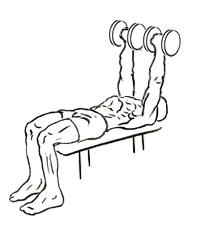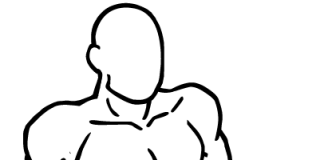Last Updated on September 24, 2014
When it comes to building triceps strength, there are a few exercises that target the muscle effectively while adding variety to your workout. One such exercise is the Lying Triceps Extension Across Face with Dumbbell. It’s a challenging movement that directly isolates the triceps, making it ideal for those looking to develop muscle definition and strength in the upper arms.
But this exercise is also risky if not performed correctly, especially since the weight is lifted directly over your face. Let’s break down everything you need to know to master this advanced move safely and effectively.
Who Should Do This Exercise?
The Lying Triceps Extension Across Face with Dumbbell is classified as an advanced exercise. Unlike standard triceps extensions, this movement places more tension on your triceps and engages stabilizing muscles in the shoulders and core.
Who This is For:
- Intermediate to advanced weightlifters
- Individuals with solid triceps strength and stability
- Those looking to isolate the triceps more effectively for hypertrophy
Who Should Avoid It:
- Beginners with limited triceps or shoulder stability
- Individuals with past shoulder or elbow injuries
- Anyone who struggles with stability or fatigues quickly, as this exercise requires controlled movement and focus
Benefits of Lying Triceps Extension Across Face with Dumbbell
This exercise provides several unique benefits:
- Isolates the Triceps: By lowering the weight across the face, you’re able to emphasize the long head of the triceps, which can lead to improved muscle definition and strength.
- Targets Muscle Weak Points: The controlled movement pattern can help expose and work on weak areas within the triceps.
- Enhances Stability: This move challenges stabilizer muscles in the shoulders and core, contributing to overall upper body stability and strength.
- Improves Grip and Wrist Strength: Holding the dumbbells with an overhand grip allows you to work on wrist stability and grip strength, a key component for other upper body lifts.
Step-by-Step Guide to Performing the Exercise
1. Position Yourself on a Flat Bench
- Start by lying on a flat bench. Position your body so that your head is at one end, and ensure your feet are planted firmly on the floor for stability.
- Engage your core and keep your back flat on the bench.
2. Grip the Dumbbells Correctly
- Select a weight that allows you to perform the exercise with control (ideally one that’s manageable for at least 8-12 reps).
- Grasp a dumbbell in each hand with an overhand grip, palms facing up. This hand position is crucial as it targets the triceps more directly and keeps the elbows stabilized.
3. Raise the Dumbbells Over Your Body
- Bring the dumbbells directly over your face with your arms extended toward the ceiling.
- Ensure that your arms are fully straight but not locked at the elbows. Locking your elbows could put excessive pressure on the joint and increase the risk of injury.
4. Slowly Lower the Dumbbells
- Here’s where technique really matters. Keep your upper arms and elbows still while bending your elbows to lower the dumbbells across your face.
- Avoid moving your shoulders or letting your arms swing. The movement should be slow and controlled to avoid putting unnecessary strain on your shoulders.
- Lower the dumbbells until they’re at around the same level as your forehead. This range of motion should feel comfortable, not forced.
5. Return to Starting Position
- Once you’ve reached the bottom of the movement, pause briefly. Then, slowly extend your arms to bring the dumbbells back to the starting position.
- Repeat the movement for the desired number of repetitions on each side, maintaining the same control and avoiding any jerky movements.
Tips for Perfecting Your Form
Form is everything in an exercise like the Lying Triceps Extension Across Face. Here are some tips to help you get it right:
- Control the Eccentric (Lowering) Phase: The slower you lower the weights, the more you’ll engage the triceps. Control prevents injury and maximizes muscle activation.
- Avoid Locking Your Elbows: Keeping a slight bend at the top helps reduce strain on the elbow joint and keeps the tension on the triceps.
- Watch Your Range of Motion: Lower the dumbbells only as far as comfortable. Overextension can lead to shoulder or elbow discomfort.
- Focus on Breathing: Inhale as you lower the dumbbells and exhale as you extend your arms back up.
- Stay Alert: Since you’re lifting directly over your face, don’t perform this exercise if you’re fatigued. Fatigued muscles increase the risk of dropping the weight.
Common Mistakes and How to Avoid Them
Even experienced lifters make mistakes in this advanced movement. Here are the most common ones to watch out for:
- Using Too Much Weight: This is an isolation exercise, so heavy weights aren’t necessary. Focus on form and control rather than lifting too much.
- Swinging the Arms: Moving your shoulders or letting your arms swing shifts the focus away from the triceps. Keep everything but your elbows stable.
- Overextension: Lowering the dumbbells too far can place excess strain on the elbows and shoulders.
- Elbow Flaring: Avoid letting your elbows move out to the sides. They should stay directly over your shoulders throughout the exercise to maintain focus on the triceps.
Variations and Modifications
Adding variety can keep your workouts fresh and help you hit different areas of the triceps. Here are some alternatives:
- Single Arm Extension: Perform the exercise with one dumbbell at a time. This version increases the demand on core stability.
- Alternating Arms: Lower one dumbbell at a time, alternating arms. This variation allows you to focus on one arm’s strength and stability.
- Seated Overhead Triceps Extension: Sit on a bench and lift a dumbbell overhead, lowering it behind your head and then extending back up. This exercise also targets the triceps, though it engages the shoulders slightly more.
Sample Workout Routine
Incorporate the Lying Triceps Extension Across Face with Dumbbell into a broader triceps workout:
- Warm-Up: Light cardio for 5-10 minutes, followed by dynamic stretching for the upper body.
- Triceps Pushdown: 3 sets of 10-12 reps
- Overhead Dumbbell Extension: 3 sets of 10 reps
- Lying Triceps Extension Across Face with Dumbbell: 3 sets of 8-10 reps (focus on form)
- Close-Grip Push-Ups: 2 sets to failure for a final burnout
Safety Tips for Advanced Lifters
This exercise demands focus and should be approached with caution:
- Spotter or No Spotter? While not always necessary, having a spotter can be helpful, especially as you work with heavier weights.
- Start with Lower Weights: Even if you’re used to heavy lifting, start light with this exercise to get comfortable with the movement.
- Avoid When Fatigued: Since this exercise involves lifting directly over your face, it’s best to avoid it if your arms are already tired.
Progressive Overload
To see continued gains, consider progressive overload by:
- Increasing Weight Gradually: Slowly increase the weight in 1-2 kg increments.
- Adding Repetitions: Once you’re comfortable with 8 reps, increase to 10-12 for added intensity.
- Adding a Pause: Pause briefly at the bottom of each rep for more time under tension.
Integrating Triceps Extensions Across Different Workouts
The Lying Triceps Extension Across Face with Dumbbell fits well into various workout splits:
- Upper Body Day: Pair it with biceps curls, shoulder presses, and chest exercises.
- Push Day: Combine with chest presses, shoulder presses, and other triceps movements.
- Arm Day: Mix it with biceps isolation exercises and different triceps exercises for a balanced arm workout.
Tracking Your Progress
Keep a workout log to track:
- Reps and Sets: Document your progress in terms of the number of reps and sets you complete.
- Weight Used: Record the weight used to see gradual improvement.
- Form Quality: Note any form adjustments needed to avoid bad habits.
Final Thoughts
The Lying Triceps Extension Across Face with Dumbbell is a challenging yet rewarding exercise for those who are serious about building triceps strength and definition. By focusing on controlled movement, form, and progressive overload, you can safely incorporate this advanced move into your routine. Just remember to avoid this exercise if fatigued, keep safety in mind, and enjoy the results!e.








